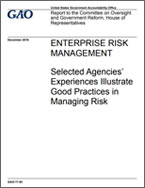 United States Government Accountability Office – GAO
United States Government Accountability Office – GAO
Sinopse: Federal government leaders manage complex and inherently risky missions across their organizations, such as protecting Americans from health threats, preparing for and responding to natural disasters, building and managing safe transportation systems, advancing scientific discovery and space exploration, maintaining a safe workplace, and addressing security threats. Managing these and other complex challenges, requires effective leadership and management tools and commitment to delivering successful outcomes in highly uncertain environments.
While it is not possible to eliminate all uncertainties, it is possible to put in place strategies to better plan for and manage them. Enterprise Risk Management (ERM) is one tool that can assist federal leaders in anticipating and managing risks, as well as considering how multiple risks in their agency can present even greater challenges and opportunities when examined as a whole. Risk is the effect of uncertainty on objectives with the potential for either a negative outcome or a positive outcome or opportunity. The Office of Management and Budget (OMB) defines ERM as an effective agency-wide approach to addressing the full spectrum of the organization’s significant internal and external risks by understanding the combined impact of risks as an interrelated portfolio, rather than addressing risks only within silos. An example of an agency enterprise risk is unfilled mission critical positions across the entire organization that when examined as a whole could threaten the accomplishment of the mission.
